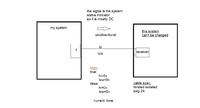simonak
Newbie level 6

hello,
I need help in finding an ic or designing a circuit
that will convert and drive single ended to differential line (digital)
but the differential logic levels is different than the normal:
true: hi: 5v
lo:0v
false: hi: 0v
lo: 0v
thank you
I need help in finding an ic or designing a circuit
that will convert and drive single ended to differential line (digital)
but the differential logic levels is different than the normal:
true: hi: 5v
lo:0v
false: hi: 0v
lo: 0v
thank you


